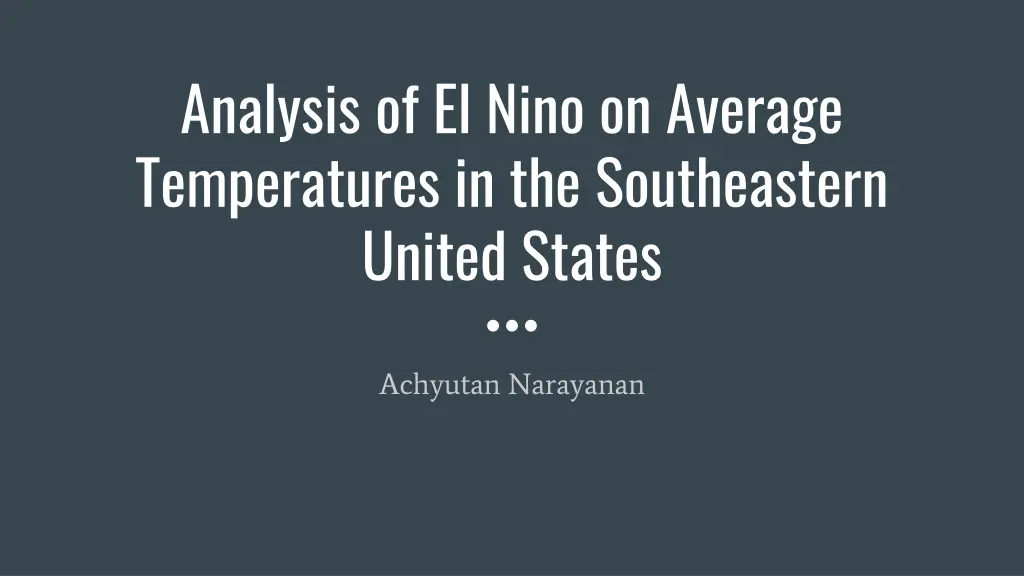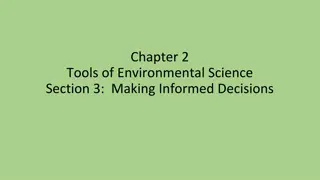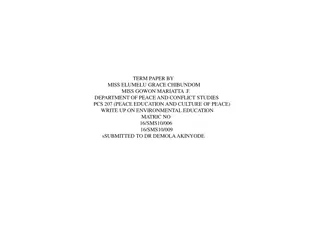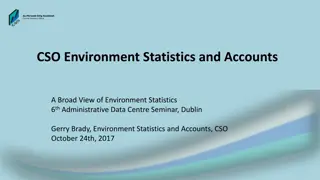
El Nino Impact on Southeastern US Temperatures
Explore the analysis of El Nino on average temperatures in the southeastern United States. The study focuses on the effects of the El Nino Southern Oscillation (ENSO) on a specific region using CMIP6 data and PCR analysis. Discover correlations between SST deviations and ENSO phases, as well as main periods of ENSO cycles. Gain insights into how ENSO influences temperatures in the southeastern US.
Download Presentation

Please find below an Image/Link to download the presentation.
The content on the website is provided AS IS for your information and personal use only. It may not be sold, licensed, or shared on other websites without obtaining consent from the author. If you encounter any issues during the download, it is possible that the publisher has removed the file from their server.
You are allowed to download the files provided on this website for personal or commercial use, subject to the condition that they are used lawfully. All files are the property of their respective owners.
The content on the website is provided AS IS for your information and personal use only. It may not be sold, licensed, or shared on other websites without obtaining consent from the author.
E N D
Presentation Transcript
Analysis of El Nino on Average Temperatures in the Southeastern United States Achyutan Narayanan
Introduction The El Nino Southern Oscillation (ENSO) is a periodic fluctuation of sea surface temperature and atmospheric pressure in the tropical Pacific. There are 2 major phases: El Nino - Warmer than average sea surface temperatures in the tropical Pacific. La Nina - Colder than average sea surface temperatures in the tropical Pacific. The effect of the ENSO circulation is worldwide, as it affects atmospheric circulation patterns throughout the word. This paper s goal is to analyze the effect of ENSO on a smaller region of the world - the southeastern US (where I live).
Data All the data was obtained from CMIP6 (Climate Model Intercomparison Project 6) Specifically, the CESM-2 model. Data range was 1850-2014 (1980 months) Data resolution was 180x360 for SST data and 192x288 for the surface temperature data. Global scale A total of 237790080 data points
PCR Analysis of ENSO Before doing the comparison between SST and Southeast US temperature data, I first did a principal component analysis (EOF) to find the principal component of SSTs that accounted for most of the variance in the data. This was done over the Nino 3.4 region (120- 170 W, 5S to 5 N) The principal component v-vector turned out to indicate that whenever the u-phase is positive, there is La Nina (as per the fact that SST was below average in the primary v-vector).
ENSO vs Nino 3.4 Index To confirm the correlation between the u- vector and ENSO phases, I compared the u- vector to the Nino 3.4 index, calculated by finding the average sea surface temperature over the region at a certain point and subtracting the overall average from it. The correlation was calculated using a least-squares regression. There was a strong and significant negative correlation between SST deviations and the u- vector. r = -0.9954, confidence interval: (-0.9958, -0.9950) p-value: ~0
ENSO Periodogram I also made a periodogram and a CPSD with the Nino 3.4 index and u-phase to look at the main periods of ENSO through the methods used here. The main periods (highest amplitude) were 1 year, 3.12 years, and 3.75 years, which makes sense given that ENSO is a 3-6 year cycle. The 1 year period is just SSTs changing with the seasons.
ENSO vs Temperatures in the Southeast - All Year To begin with, I compared the ENSO phases (u-vector) with 2m air temperature deviations from average for each month/data point in the data analysis. The area that was considered the southeast US was 80-90 W and 25-35 N. This was done using a least-squares regression. There was a positive correlation between how far above average temperatures would be in a given month and the ENSO phase that month, but it was weak. r = 0.1705, confidence interval: (0.1274, 0.2130) p = 2.1753e-14
ENSO vs Temperatures in the Southeast - Winter El Nino and La Nina both affect the location of the polar jet in winter. Thus, I did a similar test as before with all year data, except only picking the winter months from the u-vector and the southeast temperature deviations. This time, there was a significant and moderately strong positive correlation. r = 0.3653, confidence interval: (0.2864, 0.4393) p = 4.5412e-17
ENSO vs Temperatures in the Southeast - Spring I did a similar test for the rest of the seasons to see what actually affected the original correlation for all year. With spring, there was a weak but positive correlation again r = 0.1666, confidence interval: (0.0796, 0.2510) p = 1.9703e-4
ENSO vs Temperatures in the Southeast - Summer With summer, there was a very weak correlation, almost nothing. r = -0.1263, confidence interval: (- 0.2120, -0.0386) p = 0.0049 The p-value was rather surprising given the lack of correlation but could be due to the large number of data points.
ENSO vs Temperatures in the Southeast - Fall Fall had no correlation at all between average SE US temperatures and ENSO phase. r = 0.0127, confidence interval: (- 0.0755, 0.1007) p = 0.776
Conclusions and Future Research As per the CESM2 model, La Nina does result in higher average monthly temperatures in the southeast - but only during winter and spring, as per the data analysis done here. This is likely due to the polar jet having a significant influence during winter and spring, as mentioned before. Future research: Analyzing ERA5 data (actual SST and 2m temperature data) in a similar way Comparing actual data versus model data Looking at the other components of the variance of El Nino SST data. While the principal component accounted for significantly more variance than the rest of the components (1200 vs <250), the other components could indicate correlations with other variables, like precipitation. Analysis of changing periods of El Nino over time






















